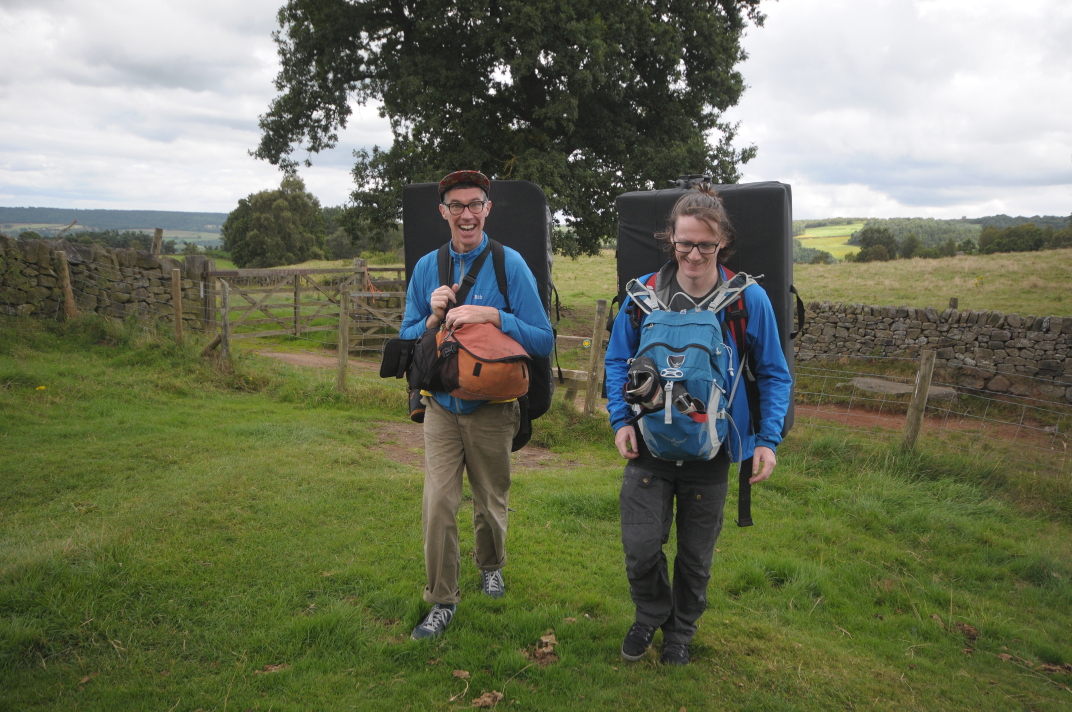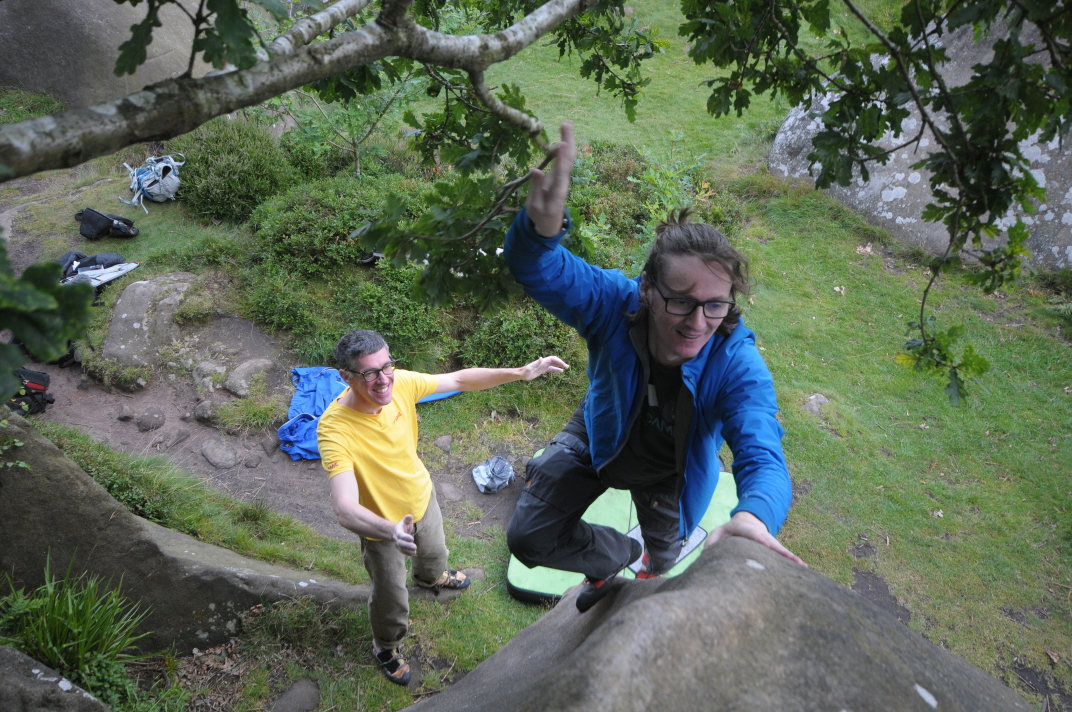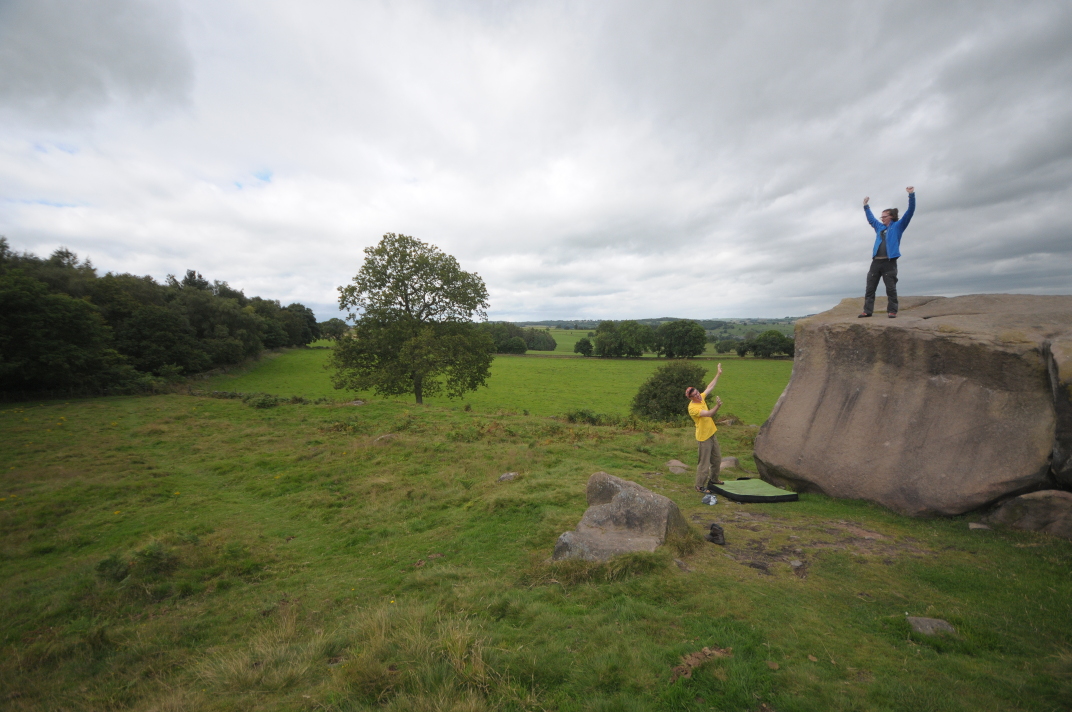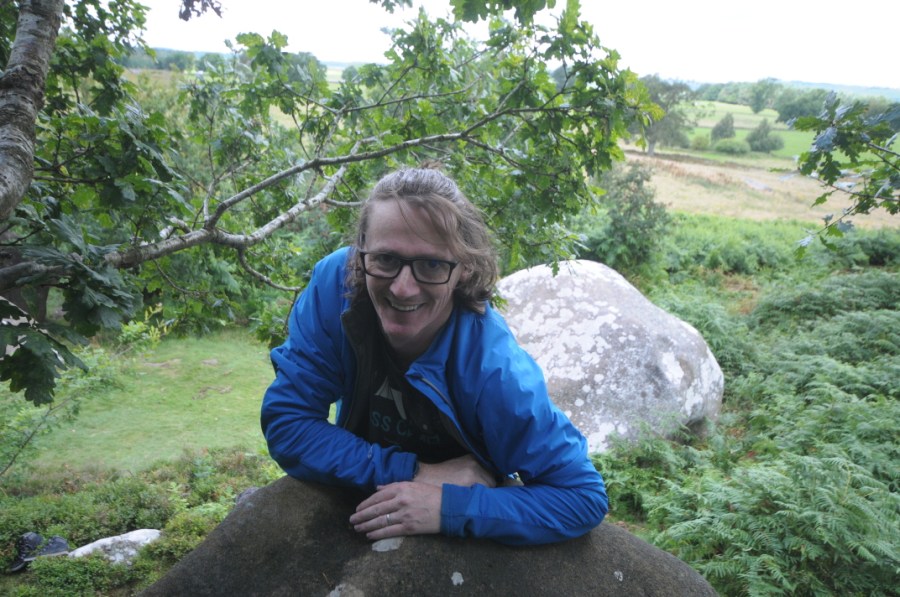Ed heads to Robin Hood’s Stride for a spot of messing about on Peak District gritstone
Ed Byrne is currently touring Britain with his new show, Spoiler Alert, as part of which he shares some hilarious insights into the trips he’s made into the hills for The Great Outdoors magazine. To celebrate, we are publishing one of his archive features each week as a treat for Ed’s fans and readers of The Great Outdoors.
This feature was first published in our October 2016 issue
I’m very fond of the Peak District. Obviously, as the site of the Kinder Trespass in 1932, it is a place that’s dear to the hearts of hillwalkers all over Britain, that event kickstarting the legislation that led to the establishment of National Parks and of the Rights of Way act. My fondness for the Peak District is more personal and sentimental. It’s where my wife comes from and it’s where we got married. As my wife’s family live there, it’s also a place I spend a fair amount of my spare time.
It’s also very beautiful. In fact, it was while driving through there with my girlfriend (now wife) one bright frosty January afternoon about 12 years ago, that I looked out at the frozen landscape and resolved, there and then, to get back into hillwalking. However, even with all its beauty, its charm, and its historical significance – both political and personal – the Peak Park has one tiny drawback for me: the hills aren’t big enough.
I know size isn’t everything. I’ve spent most of my life trying to convince others of that fact, but when it comes to walking, I’m all about the elevation gain, baby!
I know size isn’t everything. I’ve spent most of my life trying to convince others of that fact, but when it comes to walking, I’m all about the elevation gain, baby! I’m sure in the future, when my knees are ruined because I didn’t use walking poles or take enough glucosamine, the gentle undulations of the Derbyshire countryside will be ideal, but right now I like my mountains like I like my spirits: large, and preferably Scottish.
What the Peak park does have going for it, though, is gritstone. The place is covered in the stuff, making it an excellent place for devotees of rock climbing and rock climbing’s little cousin, bouldering.

Just a gritstone’s throw from where my wife grew up is Robin Hood’s Stride, a massive lump of rock sitting like a king surrounded by a court full of smaller stone subjects. This collection of slabs and crags make up a veritable bouldering playground, and it is where I meet Niall Grimes, author of Boulder Britain and guidebook editor at Climb Britain (the BMC) for a crash course in arseing about on rocks.
We start off at Cratcliffe, a selection of boulders just north-east of Robin Hood’s Stride. I complain about my climbing shoes as I slip myself into them. I was instructed by everybody I spoke to that climbing shoes should be so tight they hurt a bit, but that I’d get used to it. I haven’t done a lot of climbing and for that reason, I’m not used to the shoes I bought on a whim two years ago. Niall assures me that, as long as they’re not distorting the shape of my feet, I’ll be glad of them and their ability to glue me to the rock. Personally, I think I’d be more comfortable actually gluing myself to a rock.
Just a gristone’s throw from where my wife grew up is Robin Hood’s Stride, a massive lump of rock sitting like a king surrounded by a court full of smaller stone subjects
On a rock called Pink Slab I encounter my first problem, by which I mean my first climb is on a rock called Pink Slab. Bouldering routes are known as ‘problems’. This is, quite possibly, the most negative bit of nomenclature in the whole world of outdoor pursuits. It would be like kayakers referring to rapids as ‘troubles’ or, hikers referring to routes as ‘worries’ or skiers referring to pistes as ‘nuisances’. Actually, I believe ‘nuisance’ is the word skiers have for snowboarders.
Before I attempt Pink Slab, I remark on the holds that have been chipped into the boulder. Nick explains that such chipping took place back when sport climbing was in its infancy and is no longer practised. I’m glad to hear it. Such tiny acts of environmental vandalism are what put a lot of people off outdoor sports and outdoor sports people. However, I’m nothing if not a hypocrite, so having tutted loudly at the damage done to the rock, I make good use of these chips in order to scale it quite handily.
The next problem I attempt is right next to Pink Slab and is called Pink Arete. Niall tells me that the names given to bouldering problems are not as hard and fast as those given to rock climbs. The reason for this is that bouldering, when it began, wasn’t the sort of thing people took seriously enough. For a long time it was just something rock climbers did to stay in shape, and so folk didn’t really bother with things like problem naming or grading. Only as it grew in popularity, becoming a pastime in its own right, did the desire to name problems become pressing.

Pink Arete was supposed to be merely the next step for me before trying more difficult problems. It was, however, to prove the pinnacle of my bouldering career’s first day. Rated a measly 4+, it shouldn’t have proved too difficult but as a novice with sore feet, I found it quite a challenge. I started well, making the first few moves easily enough, but the final push for the top required me to reach for a handhold that felt tantalisingly too far while simultaneously putting a little too much pressure on a foothold I thought was tenuous at best. As I pushed hard on my right foot and reached for the top of the rock I slipped off the foothold and came half sliding/ half falling back to the crash mat. As I hit the mat, my feet made me feel like one of Cinderella’s ugly sisters trying to force themselves into a tiny glass slipper. Damn, these shoes were uncomfortable, and they didn’t even stick to the rock!
Niall insisted I have another go. “It’s all about having confidence that your feet will hold you,” he tells me. Unfortunately, I was already feeling that what little confidence I had in my feet had just been misplaced. Nevertheless, I had another go, making exactly the same amount of progress as before. On my third attempt, just as I was contemplating the final move, my left leg started shaking like a dog getting its belly scratched and I decided to jump back down before I fell. I had been beaten for today, but would try again another time.
On my third attempt, just as I was contemplating the final move, my left leg started shaking like a dog getting its belly scratched and I decided to jump back down before I fell
The day was still young, so I had a little muck about on some easier problems. The Scoop (rated 3) and Scoop Arete (4) proving fun little climbs that gave my deflated ego a tiny pump. We decided to move across to the lower boulders around Robin Hood’s Stride, but first Niall suggested I give the Pink Arete one more try. I wanted to say no but, to be honest, I thought that would make me seem like a bad sport so I acquiesced. Again, the first few moves were a doddle and in no time I was clinging on just below the final hold. I rocked gently there for what felt like an age, trying to work up the energy necessary for the final push. Images of my skin being peeled off as I slid back down the rock flashed in my mind. The knowledge that my right shoe had failed to hold me three times now weighed heavily. The fact that I was more tired now than when I had made my first attempt, all of these thoughts pressed in on my brain. I pushed. I pushed my negative thoughts away with my mind, then with my right foot, I pushed myself upwards. My foot held, I reached out and grabbed the top of the boulder and pulled myself to the top. From below Niall called, “There you go. Told ya!” I was delighted.








